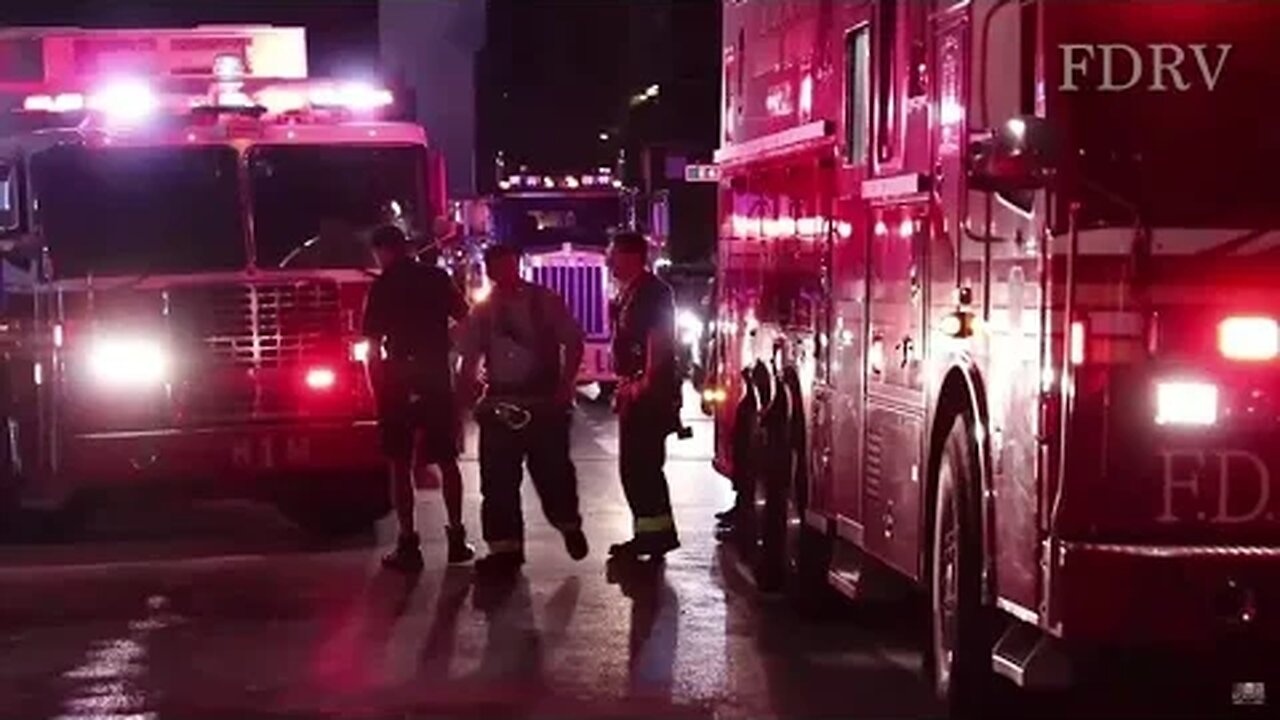Premium Only Content

RED, BLUE, AMBER WARNING LIGHTS - TOO BRIGHT, FIREHOUSE MAGAZINE: RIGHT THEN & RIGHT NOW
Emergency Warning Lights & Parking Procedures, July 6, 2006
The 1999 U.S. Fire Administration "white paper" identified the over use of blinding, confusing, and distracting warning lights as a major cause of accidents, injury and death at emergency scenes
Robert Faugh
Since the early 1950s, when the beacon ray replaced the single flashing light, we have seen more and more lights added to our emergency vehicles. It was believed that if 35 watt bulbs were good, then 100 watt must be better. If two lights made it safer, then six must make it really safe. How about a million candlepower strobe system?
We have reached the point where the warning lights are becoming the problem at emergency scenes and actually making the area less safe for our vehicles and personnel. In the last 10 years lighting your vehicles up like a Christmas tree has become the norm. When moving on the highway this may be ok, but when you are stopped or parked it is not! The 1999 U.S. Fire Administration "white paper" on this topic identified the over use of blinding, confusing, and distracting warning lights as a major cause of accidents, injury and death at emergency scenes.
We all know of emergency personnel who have been struck, killed or seriously injured and emergency vehicles that have be hit by drugged, drunk, fatigued, elderly or just confused drivers. Many of these operators stated "they were blinded or confused by all the lights". In New York State alone, an average of 80 emergency vehicles are struck while parked off the highway, on the side of the road, with all the red warning lights in operation each year. This takes place more than we would like to admit. How many close calls have you had?
Too Many Lights Distract Drivers
Every emergency vehicle has more than enough warning lights and is equipped so that if it is the only vehicle parked at a scene, the light laws are complied with. The problem is that when there are six or seven emergency vehicles at a scene, all the warning lights are left on and the area actually becomes unsafe due to all of the blinding and distracting lights. Those driving in the area of the emergency look at the vehicle warning lights and do not see the personnel who are working in the area near these vehicles. What effects do all of these warning lights have on the crowd and your own crews? Under some conditions, these warning lights also blind us! This is a major safety issue that has been ignored for too long. It is a known fact that the warning lights, at a scene will effect the crowd, shut them off and many will walk away. We set up a "carnival" and wonder why people flock to it!
The Illinois State Police and California Highway Patrol studies questioned the use of light bars on their police cars and the safety of the officers while engaged in their duties next to the roadway. The collision rate for emergency vehicles displaying lights while parked next to the highway were two and a half times higher for the same 100,000 miles driven than for non-emergency vehicles. Many highway patrol and state police departments are going to the slick top cars for safety, better mileage and productivity. Many have "arrow sticks" in the back window.
What Color Lights Are The Safest?
What about color? The knowledge of human perception calls into question the use of warning lights when the vehicle is parked off the highway. Red lights send a message: emergency, stop and invoke irrational behavior from motorist. They also tend to draw persons to the scene or area of the emergency. The psychological reaction to red is rage, anger and hostility. The human eye is more sensitive to red light during the daylight than at night. Instead of warning people to stay away, the red emergency light actually draws drivers towards the lights. This so-called moth effect refers to "a state of narrowed attention associated with excessive concentration on some object or task with the resulting loss of voluntary control over response." People drive where they look! Drugged, drunk, fatigued and elderly drivers have driven right off the roadway and into the parked vehicles displaying red warning lights........
-
 2:03:42
2:03:42
Inverted World Live
7 hours agoBigfoot Corpse Coming to the NY State Fair | Ep. 94
79.6K17 -
 LIVE
LIVE
SpartakusLIVE
8 hours ago$1,000 Pistol Challenge || #1 ENTERTAINER of The EONS Eradicates BOREDOM
762 watching -
 2:33:37
2:33:37
TimcastIRL
5 hours agoTrump Orders Review of Smithsonian For Being Woke & Out of Control | Timcast IRL
150K50 -
 3:09:10
3:09:10
Barry Cunningham
8 hours agoPRESIDENT TRUMP HAS TAKEN THE MONSTER AWAY FROM THE LEFT! HORROR STORIES WON'T WORK ANYMORE!
64K70 -
 1:29:55
1:29:55
WickedVirtue
3 hours agoLate Night Fortnite w/ Friends
25.1K -
 3:34:06
3:34:06
This is the Ray Gaming
3 hours ago $0.22 earnedCould you be? Would you be? Won't you be my RAYBOR? | Rumble Premium Creator
14.3K -
 1:46:52
1:46:52
JahBlessGames
4 hours ago🎉Come een' and come tru' - VIBES | MUSIC | GAMES
31.1K -
 38:47
38:47
MattMorseTV
6 hours ago $11.59 earned🔴Tulsi just CLEANED HOUSE.🔴
53.3K97 -
 6:24:06
6:24:06
Reolock
7 hours agoWoW Classic Hardcore | WE'RE BACK!!
20.9K1 -
 3:46:13
3:46:13
SynthTrax & DJ Cheezus Livestreams
9 hours agoShell Shock Live - The Scorched Earth Remake/Upgrade - 4pm PST / 7pm EST - RUMBLE GAMING
40.6K